Lecture

A computer mouse (simply a “ mouse ” or “ mouse ”) is a mechanical manipulator that converts motion into a control signal. In particular, the signal can be used to position the cursor or scroll pages.
Received widespread in connection with the advent of the graphical user interface on personal computers. In addition to mice, there are other input devices of a similar purpose: trackballs, touchpads, graphic tablets, and touch screens.
The mouse perceives its movement in the working plane (usually on the surface of the table) and transmits this information to the computer. A program running on a computer responds to the movement of the mouse on the screen in response to the direction and distance of that movement. In different interfaces (for example, in windowed ones) with the help of a mouse, the user controls a special cursor - pointer - manipulator with interface elements. Sometimes the use of mouse commands without the participation of visible elements of the program interface is used: with the help of an analysis of mouse movements. This method is called "mouse gestures" (English mouse gestures ).
In addition to the motion sensor, the mouse has one or more buttons, as well as additional control details (scroll wheels, potentiometers, joysticks, trackballs, keys, etc.), which are usually associated with the current cursor position (or components of a specific interface) .
The components of the mouse control are largely the embodiment of the ideas of the chord keyboard. The mouse, originally created as a supplement to the chord keyboard, actually replaced it.
Some independent devices are built into some mice - watches, calculators, phones.
On December 9, 1968, a computer mouse was presented at a display of interactive devices in California [1] . Douglas Engelbart received a patent for this gadget in 1970.
The first computer that included a mouse was the Xerox 8010 Star Information System minicomputer introduced in 1981. The Xerox mouse had three buttons and cost $ 400, which corresponds to almost $ 1,000 in 2012 prices for inflation [2] . In 1983, Apple released its own one-button mouse for the Lisa computer, the cost of which was reduced to $ 25. The mouse became widely known thanks to the use of Apple Macintosh computers and, later, in Windows OS for IBM PC compatible computers. A computer mouse was produced in the USSR, called the Kolobok Manipulator with a heavy metal ball that was not covered by rubber at that time.
In the process of "evolution" of a computer mouse, displacement sensors underwent the greatest changes.
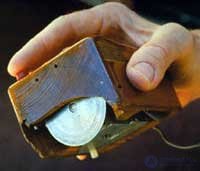
The original design of the mouse displacement sensor, invented by Douglas Engelbart at the Stanford Research Institute in 1963, consisted of two perpendicular wheels protruding from the body of the device. When moving the mouse, the wheels spun each in its own dimension.
This design had many flaws and was soon replaced with a spherical mouse.
In the ball drive, the movement of the mouse is transmitted to a rubberized steel ball protruding from the body (its weight and rubber coating ensure good adhesion to the working surface). Two rollers pressed to the ball remove its movements in each of the measurements and transmit them to the rotation angle sensors (incremental encoders), which convert these movements into electrical signals.
The main drawback of the ball drive is the contamination of the ball and the pulleys, which causes the mouse to jam and the need to clean it periodically (this problem was partially smoothed out by metallizing the rollers). Despite the shortcomings, the ball drive dominated for a long time, successfully competing with alternative sensor circuits. Currently, ball mice are almost completely supplanted by second-generation optical mice.
There were two options for sensors for ball drive.
The contact sensor is a textolite disk with radial metal tracks and three contacts pressed against it. This sensor went to the ball mouse "inherited" from the direct drive.
The main disadvantages of contact sensors are the oxidation of contacts, rapid wear and low accuracy. Therefore, over time, all mice switched to contactless optocouplers.
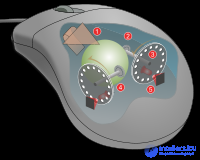
The optical sensor consists of a double optocoupler - an LED and two photodiodes (usually infrared) and a disk with holes or radial slots that block the light flux as it rotates. When you move the mouse, the disk rotates and a signal is taken from the photodiodes at a frequency corresponding to the speed at which the mouse moves. The difference in illumination phases between two photodiodes determines the direction of rotation. A similar sensor is on the scroll wheel.
Optical sensors are designed to directly track the movement of the working surface relative to the mouse. The exclusion of the mechanical component ensured a higher reliability and made it possible to increase the resolution of the detector.
The first generation of optical sensors was represented by various schemes of optocouplers with indirect optical coupling — light-emitting and light-sensitive diodes that receive reflection from the working surface. Such sensors had one common feature - they required the presence of a special hatching (perpendicular or diamond-shaped lines) on the working surface (mouse pad). On some rugs, these hatchings were made with colors that are invisible in ordinary light (such rugs could even have a pattern).
The disadvantages of such sensors are usually called:
In the USSR, optical mice of the first generation, as a rule, were found only in foreign specialized computing complexes. [ clear ]
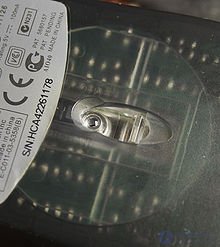
The second generation of optical mice has a more sophisticated device. At the bottom of the mouse installed a special fast video camera. She continuously takes pictures of the surface of the table and, comparing them, determines the direction and magnitude of the displacement of the mouse. Special contrast illumination of the surface with a LED or laser facilitates camera operation. Optical mice of the second generation have a huge advantage over the first: they do not require a special pad and work on virtually any surface other than specular or transparent; even on the fluoroplastic (including black).
Almost the only sensor manufacturer of optical mice is Avago Technologies. Its sensors have a resolution of 16 * 16 to 40 * 40 pixels at several thousand frames per second. A specialized digital signal process for calculating displacements is integrated onto a crystal along with a sensor.
It was assumed that such mice would work on an arbitrary surface, but it soon became clear that many models sold (especially the first widely sold devices) were not so indifferent to the surface texture or patterns on the mat. In some parts of the picture, the graphics processor is capable of making a lot of mistakes, which leads to random pointer movements that do not correspond to the actual movement. For mice prone to such disruptions, it is necessary to choose a rug with a different pattern. Features of contrasting illumination lead to mouse errors on smooth surfaces such as mirrors.
Dust and lint on the optics of the sensor also leads to movement errors or the effect of small movements at rest, which is manifested by a pointer shake on the screen, sometimes with a tendency to creep in one direction or another.
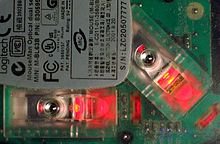
The sensors of the second generation are gradually being improved, and nowadays, mice that are prone to malfunction are much less common. In addition to improving sensors, some models are equipped with two displacement sensors at once, which allows analyzing changes in two areas of the surface at once to eliminate possible errors. Such mice are sometimes able to work on glass, plexiglass and mirror surfaces (on which other mice do not work).
Also produced mouse pads, specifically focused on optical mice. For example, a rug that has a silicone film with a suspension of glitter on the surface (it is assumed that the optical sensor detects movement on such a surface much more clearly).
Also, some people attribute the flaws of optical mice to the flaws of such mice, even with the computer turned off. Since most low-cost optical mice have a translucent body, it lets the red light through the LEDs, which makes it difficult to fall asleep if the computer is in the bedroom. This happens if the voltage on the PS / 2 and USB ports is supplied from the standby voltage line; Most motherboards allow you to change this with a jumper of + 5V <-> + 5VSB, but in this case it will not be possible to turn on the computer from the keyboard. To fix this problem, you can also buy a mouse with an infrared LED backlight.
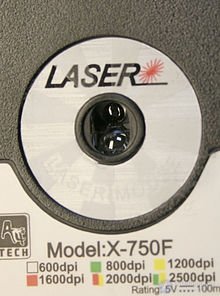
In recent years, a new, more sophisticated type of optical sensor has been developed that uses a semiconductor laser to illuminate [3] .
Little is known about the disadvantages of such sensors, but their advantages are known:
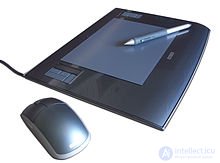
Induction mice use a special pad that works on the principle of a graphic tablet or is included in the complete set of a graphic tablet. Some tablets incorporate a manipulator similar to a mouse with a glass crosshair, which works on the same principle, but differs slightly in implementation, which allows to achieve increased positioning accuracy by increasing the diameter of the sensitive coil and removing it from the device to the user's view.
Induction mice have good accuracy and do not need to be properly oriented. The induction mouse can be “wireless” (the tablet on which it works is connected to the computer), and can have the same induction power, therefore, does not require batteries, like ordinary wireless mice.
The mouse in the complete set of the graphic tablet will allow to save a little space on the table (provided that it always has a tablet).
Induction mice are rare, expensive and not always convenient. A mouse for a graphic tablet is almost impossible to change to another (for example, more suitable for a hand, etc.).
A mouse equipped with a gyroscope recognizes movement not only on the surface, but also in space: you can take it from the table and control the movement of the brush in the air.
Gyroscopic sensors are being improved. For example, according to Logitech, mechanical sensors based on MEMS technology used in the MX Air mouse are smaller than traditional gyroscopic sensors. To date, the most miniature gyro sensor equipped with a mouse (NEO MOUSE), developed by the Korean company NEO REFLECTION. The weight of the "Neo mouse" is only 13 grams, and in size it is no more than a finger-type battery.
Buttons are the basic controls of the mouse that serve to perform basic manipulations: selecting an object (pressing), active movement (that is, moving with the button pressed, drawing or marking the beginning and end of a segment on the screen, which can be interpreted as a diagonal of a rectangle, a circle diameter, the source and end point when moving the object, text selection, etc.).
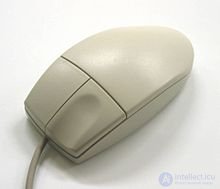
The number of buttons on the mouse limits the concept of their use blindly, similar to the keys of the chord keyboard. However, unlike the chord keyboard, which can safely use five keys (one for each finger), the mouse still needs to be moved with three (thumb, ring and little fingers) or two (thumb and thumb) with fingers. Thus, you can make two or three full buttons for use in parallel with moving the mouse around the table - under the index, middle and ring fingers (for three buttons). The outermost buttons are called by position - left (under the right index finger), right and middle , for a three-button mouse.

For a long time, two- and three-button concepts confronted each other. At first, two-button mice were in the lead, since on their side, besides simplicity (the three buttons were easier to confuse), convenience and lack of excesses, there was software that barely loaded two buttons. But, in spite of everything, the three-button mice never stopped being sold until the opposition came to an end.
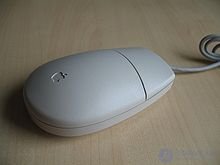
The confrontation of two- and three-button mice ended after the appearance of scrolling the screen (scroll), a new popular opportunity. On a two-button mouse, a small middle (third) button appeared to turn on and off scrolling, which soon transformed into a scroll wheel, pressing which works as a middle button.
Apple has come to use additional mouse buttons in its own way. Initially, finding even the second button unnecessary, until recently, Apple built all its interfaces under a one-button mouse. However, modern Apple-made mice, starting with the Mighty Mouse, can be programmed to use from one to four buttons.
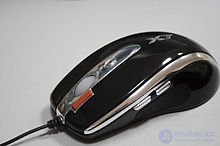
Manufacturers are constantly trying to add additional buttons to the top models, most often - buttons under the thumb or forefinger and less often - under the middle finger. Some buttons are used for internal settings of the mouse (for example, to change the sensitivity) or double-triple clicks (for programs and games), to others - some system functions are assigned to the driver and / or a special utility, for example:
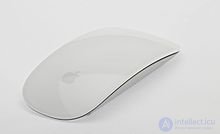
In 2009, Apple introduced the Magic Mouse, which is the world's first mouse with touch controls and multitouch technology. Instead of buttons, wheels and other controls in this mouse, a touch pad is used [5] , which allows using various gestures to press, scroll in any direction, zoom the image, navigate through the history of documents, etc.
Большинство элементов, не являющихся кнопками, служат для прокрутки (скроллинга) контента (веб-страница, документ, список, листбокс и т. п.) в окнах приложений и других элементах интерфейса (например, полосах прокрутки). Среди них можно выделить несколько конструктивов.
Колёса и потенциометры — диски, выступающие из корпуса, доступные для вращения. Потенциометры, в отличие от колёс, имеют крайние положения.
Наличие одного колеса между кнопками (или «скролла»; для вертикальной прокрутки) на сегодняшний день является стандартом де-факто. Такое колесо может отсутствовать у концептуальных моделей, имеющих для прокрутки иные конструктивы.
Также колёса и потенциометры могут быть использованы для регулировки, например, громкости.
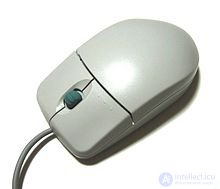
Мини джойстик — рычаг с двумя кнопками, исключающее одновременное нажатие обеих кнопок (или сдвоенное под прямым углом плечо, ориентированное в четырёх основных направлениях). Плечо может иметь центральный рычажок или, наоборот, центральное углубление (аналогично джойстикам игровых пультов). Изредка встречаются мини джойстики с потенциометром.
Кроме вертикальной и горизонтальной прокрутки, джойстики мыши могут быть использованы для альтернативного перемещения указателя или регулировок, аналогично колёсам.
Трекбол — шарик, вращающийся в любом направлении. Движения шарика снимаются механическим (как в механической мыши) или оптическим способом (применяемым в современных трекболах).
Трекбол можно рассматривать как двухмерное колесо прокрутки. Аналогично джойстику, трекбол может быть использован для альтернативного перемещения указателя. Трекболы обычно используются специалистами, такими, как звукооператорами и другими, так как чтобы вращать шарик пальцами, нужно достаточно долго привыкать. Однако, трекбол обеспечивает более точное позиционирование курсора, чем мыши. В настоящее время почти не используется.
Сенсорные полоски и панели (тачпад) — элементы, определяющие перемещение пальца по поверхности. Полоски определяют движение в одном измерении (как колёса), панели — в двух (как трекболы).
Сенсорные полоски и панели выполняют те же функции что колеса с трекболами, но не имеют движущихся частей.
Гибридные элементы управления объединяют в себе несколько принципов.
Колёса, джойстики и трекболы могут включать в себя кнопку, срабатывающую при прямом нажатии на элемент управления. Так, стандартное колесо прокрутки одновременно является средней кнопкой мыши.
Колесо может иметь элементы джойстика — свободу наклона по оси вращения. Таково качающееся колесо прокрутки (наклон колеса служит для горизонтальной прокрутки), оно одновременно является колесом, джойстиком и кнопкой.
Самые первые мыши (шарикового типа) не имели внутри себя ничего кроме датчиков и кнопок, и подключались к компьютеру с помощью своего адаптера ( шинные мыши англ. bus mouse ) с шиной ISA, в котором и обрабатывались сигналы с датчиков.
Позднее, с развитием миниатюризации электронных компонентов, мыши стали подключаться к компьютерам x86 через последовательный коммуникационный интерфейсRS-232 (последовательные мыши) с разъёмом DB25F и, позднее, DB9F. В 1990-х годах большинство выпускавшихся мышей уже имели последовательное подключение. Последовательная мышь питалась от линии DTR («готовность компьютера») разъёма RS-232.
В компьютере PS/2 фирма IBM предусмотрела для мыши специальный порт с разъемом mini-DIN, точно таким же, как и для клавиатуры. Позднее разъёмы клавиатуры и мыши типа PS/2 были включены в современный стандарт материнских плат x86 — ATX. Такие мыши лидировали в продаже в период 2001—2007 гг. и используются до сих пор, постепенно уступая свои позиции интерфейсу USB. Из-за особенностей аппаратной части IBM-совместимых компьютеров, интерфейс PS/2 мышей деактивировался при загрузке, если мышь не была подключена, и при загруженном компьютере включать ее в разъем было бесполезно, однако такие мыши не нагружали центральный процессор компьютера и работали более плавно в ранних вариантах компьютеров с шиной USB. Первоначально мышки PS/2 и RS-232 имели преимущество в виде возможности передавать отсчеты в компьютер с более высокой частотой — частота опроса первых USB мышей ограничивалась частотой фреймов шины USB 1.1 (1 кГц).
A variety of mice with a “wireless” interface are available. Most often they are built on a specialized radio channel, but wireless mice with a universal Bluetooth wireless radio interface are becoming increasingly popular.
Most modern mice have a USB interface, sometimes with an adapter for PS / 2. Apple currently provides only Bluetooth-enabled mice for its computers, although USB mice can also be used.
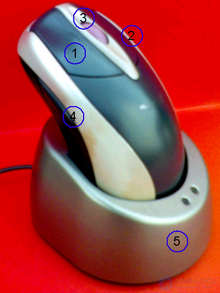
Сигнальный провод мыши иногда рассматривается как мешающий и ограничивающий фактор. Этого фактора лишены беспроводные мыши . Однако беспроводные мыши имеют серьёзную проблему — вместе с сигнальным кабелем они теряют стационарное питание и вынуждены иметь автономное, от аккумуляторов или батарей, которые требуют подзарядки или замены, а также увеличивают вес устройства.
Аккумуляторы беспроводной мыши могут подзаряжаться как вне мыши, так и внутри неё (точно так же, как аккумуляторы в мобильных телефонах). В последнем случае, мышь должна периодически подсоединяться к стационарному питанию через кабель, док-станцию или площадку для индукционного питания.
The first attempts were the introduction of an infrared connection between the mouse and a special receiving device, which, in turn, was connected to the computer port.
Optical communication in practice showed a major drawback: any obstacle between the mouse and the sensor interfered with work.
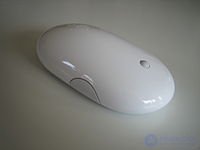
The radio communication between the mouse and the receiver connected to the computer eliminated the drawbacks of the infrared connection and supplanted it.
Можно выделить три поколения беспроводных мышей. Первое поколение использовало частотные диапазоны, предназначенные для радиоуправляемых игрушек (27 МГц). Они имели низкую частоту опроса (типично 20-50 Гц), неустойчивую связь, взаимное влияние при близком расположении. Такие мышки имели курьезную проблему: поскольку радиус действия этих мышей составлял несколько метров, а организации, как правило, закупали однотипную технику партиями, бывали случаи, когда курсором на экране компьютера управляла мышь, расположенная даже на соседнем этаже. Такие мыши, как правило, имеют переключатель, позволяющий выбрать один из двух радиочастотных каналов, в большинстве случаев переход на другой канал снимал проблемы. В настоящее время мышки первого поколения уже не производятся.
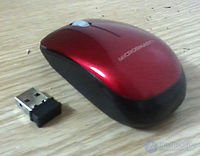
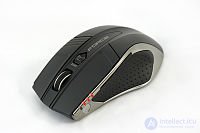
Второе поколение радиомышей использовало свободный частотный диапазон 2,45 ГГц и строилось на базе высокоинтегрированных скоростных радиоканалов. В таких решениях удалось полностью избавиться от «детских болезней» первого поколения. Основным недостатком считается необходимость в специальном USB-донгле, в котором находится приемник мышки. Такой донгл занимает USB-слот на компьютере. Потеря донгла делает мышку мертвым железом из-за несовместимости методов радиосвязи разных производителей. Мышки второго поколения — наиболее массовые в настоящее время.
The third generation of radio mice uses standard radio interfaces. As a rule, it is Bluetooth or (much less often) other standard radio interfaces of personal networks. Bluetooth mice do not need a special dongle, as modern computers are equipped with this interface. Another advantage of Bluetooth mice is that no special drivers are required. The disadvantage of Bluetooth is the high price and higher power consumption.
Induction mice most often have induction power from a special working platform (“carpet”) or a graphic tablet. But such mice are wireless only in part - the tablet or platform is still connected with a cable. Thus, the cable does not interfere with moving the mouse, but it also does not allow working at a distance from the computer, as with a conventional wireless mouse.
Siemens AG has developed a fingerprint scanner mouse for control systems.
Since the end of the 20th century, the production of accessories has been gaining ever greater power especially for gamers. This trend has not bypassed computer mice. This subspecies differs from its usual office counterparts with greater sensitivity (up to 8200 dpi for the Razer Taipan), the presence of additional, individually customizable buttons, a non-slip outer surface, and design. In gaming mice of the highest class, the weight is adjusted - this is necessary so that all the legs of the mouse are evenly loaded (so the mouse slides more smoothly).
Like any element of the computer, the mouse has become an object for modding.
Some manufacturers of mice add to the mouse alert functions for any events occurring in the computer. In particular, Genius and Logitech release models that indicate the presence of unread e-mails in the mailbox by LED lighting or playing music through the built-in mouse speaker.

There are cases of placing a fan inside the mouse casing for cooling while the user's hand is working with air flow through special holes. Some models of mice, designed for gamers, have small eccentrics built into the mouse body that provide a sense of vibration when fired at computer games. Examples of such models are the Logitech iFeel Mouse line of mice.
In addition, there are mini-mice created for laptop owners with small dimensions and weight.
Some wireless mice have the ability to work as a remote control (for example, Logitech MediaPlay). They have a slightly modified form for working not only on the table, but also when held in hand.
The mouse has become the primary input coordinate device due to the following features:
The disadvantages of the mouse are:
According to the magazine "Home PC" [6] .
Players distinguish between three basic ways to grip the mouse.
Office mice (with the exception of small mice for laptops) are usually equally suitable for all types of grip. Gaming mice, as a rule, are optimized for one or another grip - therefore, when buying an expensive mouse, it is recommended to “try on” the mouse for your grip method.
A distinctive feature of mice as a class of devices is the good standardization of hardware protocols.
Thanks to this feature, one standard driver that comes with the OS, and even the computer BIOS can work with almost any mouse. Additional software is needed only to maintain the specific capabilities of the product. Additional features are non-standard and have limited software support.
For professional cybersportsmen, the most important characteristic of a mouse is the number of DPIs [7] .
Comments
To leave a comment
Electromechanical devices of electronic devices
Terms: Electromechanical devices of electronic devices